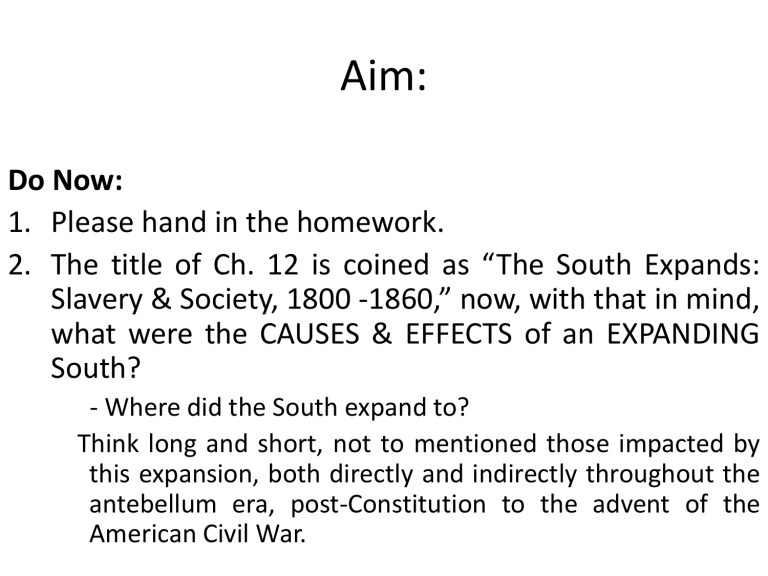Ch. 12 - The South Expands - Slavery & Society, 1800

Aim:
Do Now:
1. Please hand in the homework.
2. The title of Ch. 12 is coined as “The South Expands:
Slavery & Society, 1800 -1860,” now, with that in mind, what were the CAUSES & EFFECTS of an EXPANDING
South?
- Where did the South expand to?
Think long and short, not to mentioned those impacted by this expansion, both directly and indirectly throughout the antebellum era, post-Constitution to the advent of the
American Civil War.
Aim: What were the Causes & Effects of
America’s Domestic Slave Trade throughout the Antebellum Era?
Do Now:
1. Please hand in the homework.
2. Slavery and the Impeding Crisis of Union:
From 1775 to 1830, many African Americans gained freedom from slavery, yet during the same period the institution of slavery expanded.
Explain why BOTH of those changes took place.
1775 to 1830
• Revolutionary War
• Framing the Constitution
• The Early Republic (GW—Monroe)
(Era of Good Feelings)
• Age of Reform
• Age of Jackson
Characteristics of the Antebellum South
1.
Primarily agrarian.
2.
Economic power shifted from the
“upper South” to the “lower South.”
3.
“Cotton Is King!”
* 1860
5 mil. bales a yr.
(57% of total US exports).
4.
Very slow development of industrialization.
5.
Rudimentary financial system.
6.
Inadequate transportation system.
Cotton Production
• This was not always the case – as you may remember, slavery appeared to be naturally
“dying” with the progression of time throughout the post-revolutionary war era.
• Why? What happened?
Slave Importation banned in 1807, stipulated in the U.S. Constitution
Missouri Compromise, 1820
Why? What led to this grand spike in
Cotton?
1793- Eli
Whitney invents cotton Gin
The Cotton Gin
- A major turning point in U.S History. Why? This simple invention by Eli Whitney made cotton profitable – making cotton “King” in America –
As a result, new land and laborers, preferably
FREE was greatly desired….
- As a result, the gradual end to American slavery was halted, leading to the vast/rapid growth in American slave laborers.
Value of Cotton Exports
As % of All US Exports
Slavery & The Expanding South
• By 1817 the southern plantation system was rapidly expanding.
• Cotton was THE cash crop.
• America had begun to expand out west - more open land
• Louisiana Purchase
• Adams-Onis Treaty
• Indian removal
• Annexation of Texas (TBA) to come.
• More land & more cotton meant more increase in the need/demand slave labor.
production
$$$$, thus the result was an of
Need for land?
Indian Removal Act opens up land for cotton Plantations
War = Texas Republic 1836-1845
• Sam Houston 1 st President
• Van Buren doesn’t annex- conflict
By 1840, The South
Produced 2/3 of the
World’s Cotton
By 1860, the South’s economy ranked
4 th in the World and whites had a higher PCI than France or Germany.
Redistribution of Slavery
1790-1860
• The cotton boom that began in the 1810s set in motion a great redistribution of the African American population. Between 1790 and 1860, white planters moved or sold more than a million slaves from the Upper to the Lower South.
Distribution of Slave Labor in 1850
1830-1860= A 900 mile advancement
7 new slave states (15 total)
“Great American Desert”
Cotton Gin
Market Revolution
Indian Wars, removal
Texas Annexation
Slave Trade
• The cotton boom brought about an increase in slave trade.
• African American population was growing rapidly, from natural increases.
• Congress outlawed the Atlantic Slave Trade, but illegal importing still took place.
• Other alternative was Domestic slave trade: a) costal system b) inland trading
• Domestic Slave trade was crucial to the southern economy remaining prosperous.
Between 1830-1860, 1million slaves were
Transported from upper to lower South
60% sold, 40% migrated w/ owner
Slave Coffles = a train of slaves chained/bound together. method used to transport slaves to the Lower South
The Middle Passage –
ILLEGAL?
Who needs it?
• 11.8 Africans shipped to New World
• 10-20% died on the journey
• 500,000 were imported to US
• 4.5 million slaves at time of Civil War
Slavery in Upper & Lower South
Upper South
• Traditional “Old Money”
• Tobacco, Rice, Cotton
• Higher life expectancy
• Task system labor
• Bred slaves for lower South
• Domestic Slave Trade added
20% to their income = think back to 12 Years a Slave as to how they actually enslaved him… trickery/spiked his drinks.
Lower South
• Upstart capitalists
• Cotton, Sugar Cane
• Further south= worse
• Gang Labor
• Coffles from Upper South
• Slave merchants profited
The reason for decrease of free Blacks is the natural increase of slaves. US slavery
Was the ONLY place in North America
Where there was a +natural increase of Blacks
By 1850, approximately
3000 families owned 100+ slaves
How did slavery impact
The 76% that did not own
Slaves????
Defending Slavery
• Economic
• Demanding crop with long growing season
• Market boom brought high demand
• There is money to be made
• Slaves were socially inferior economic competitors
• Moral
• A supportive social system
• Christian ideology was the root of the community
• Slaves were required to attend religious services
• Offered them a decent lifestyle
• Low % of people owned slaves (by 1860 >25%)
Impact of “King Cotton”?
A “DIVIDE UNION” – yes, an oxymoron.
Impacts of Slave-Based Economy
• Only 10% of nation’s manufacturing
• Lack of urbanization
• Stratification of society
• Lack of infrastructure- especially railroads
• Discouraged immigration
• Gave poor whites little chance to advance
Free Northern Blacks
• Discriminated against still
• Started schools
• Mutual benefit societies
• Churches (Baptist, Methodist)
Chattel Definition [Very important term]:
Moveable items of property which are neither land nor permanently attached to land or a building, either directly or vicariously through attachment to real property.
Slave Families
• Broken apart, Black English, Cousin taboos
• Fictive kinship ties , choosing “aunts and uncles”
• Naming former relatives to remember them
• “slavery had destroyed Black families, but not family values”
Objectives:
• Analyze data presented in charts and maps regarding the growth of the slave population, the domestic slave trade, the production of cotton, and the production of cotton cloth in the North. Interpret maps and charts.
• Explain how the cotton gin and the opening of new lands in the South and West led to the increased demand for slaves. Analyze cause and effect relationships.
• Identify how the economies of the North and the South were connected. Draw conclusions
• Infer how the growth of the slave population, the domestic slave trade, the production of cotton, and the production of cotton cloth in the North would make it difficult to gain supporters to the abolitionist cause.
Determine cause and effect.
Activity #1
1. Students are asked to work in groups of two to complete the questions at bottom of Worksheet 1 , which depicts the Population of the South from
1790-1860 . Students will learn that the population of slaves increased dramatically from 1.1 million in
1810 to 3.95 million in 1860. Students will respond to the listed queries: what type of problems may have resulted from this? What would slaveholding states need to do?
Note: Please do not answer the questions listed on the table/pages…. Review them. Instead, respond to the questions listed here on the PPT.
1. Next, students are asked to analyze the chart entitled Table 2: Slaves as a Percent of the Total
Population of the slaveholding states . Working with their neighbor/group member, students would now discuss which states had the greatest proportion of slaves (South Carolina, Alabama,
Florida, Georgia, Louisiana, Mississippi). Prove it – evidence?
1. What impact would this have on their governments?
Whole Class Discussion
1. Based on the chart and reading/homework assignment, what can explain the increased number of slaves?
1. What would be the implications for white planters, Northern abolitionists [black & white], and the United States as a whole?
Activity #2
1. At this point, students are asked to continue to work with their neighbor in groups of two to complete
Worksheet #2: The Domestic Slave Trade, 1808-1865 .
Here, students will examine the thriving domestic slave trade after the ban on the importation of slaves in
1808. At this point, students will complete a chart based on information presented on the map. Students will make generalizations about the domestic slave trade. Students will then analyze a chart depicting the price of slave field hands from 1800-1860. Students will identify trends in the price of slaves after the ban of theimportation of slaves. Students will attempt to explain this phenomenon.
Whole Class Discussion
1. What implications does the thriving domestic slave trade have on white planters, the abolitionist movement, and the United States?
2. Students are asked to predict which states would support the continuation of the domesticslave trade and slavery. Why?
3. Predict which states would be the most likely to secede/not wanting slavery to end, but grow.
Homework
1. Worksheet #3 Table 4: American Production of Raw Cotton,
1790-1860, Quote about U.S. exports, Table 5: Cotton
Produced and Consumed in Lowell, Massachusetts . Students will see the incredible increase in the production of cotton in the United States from 1820-1860 . Students will attempt to explain why this happened and predict the consequences of this growth. Students will see that Cotton accounted for the majority of U.S. exports which produced wealth for lots of different people. Students would recognize the tremendous increase in cotton cloth production and cotton consumption in
Lowell, Massachusetts from 1834 to 1858.
2. Students are also asked to reread pp. 357 – 366.
3. Take the time to carefully review this PPT. Please do so, for it’s very informative/helpful for future references.
Free Blacks in the South
• Lived in port cities & Upper South
• Had no rights as citizens
• Made up a large % of artisans
By 1860, 84% of
Southern farmers (more than double the North)
Worked in agriculture
1860 Manufacturing Output in the US
Southern Agricultural Society was slow to change
North was rapidly transforming into a Modern Industrial Powerhouse





